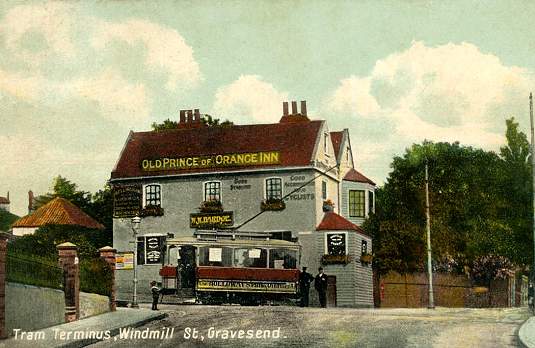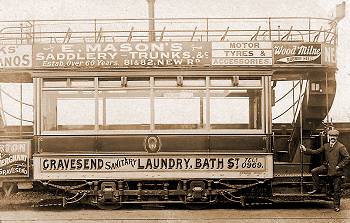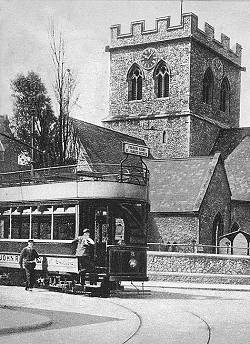

This postcard shows one of the two Raworth patented one-man demi-cars (9 & 10) at the southern terminus of the Windmill Street route in Gravesend. The trolley pole is already turned for the return journey of three-quarters of a mile back to the town centre and the uniformed driver/conductor is standing immediately behind the tram. The postcard was published by Thornton Bros of New Brompton (now part of Gillingham, Kent) as no. 244 in one of their many series of Gravesend area cards and this image dates from about 1906, this actual card having been posted in September 1907. "The Old Prince of Orange" pub was demolished in the late 1920s but replaced by a new one of the same name that still exists today. The first smaller view is of one of the original four-wheel cars 11-20 at the Dover Road depot c.1905 on a locally produced real photographic postcard. The final picture is a rare view of one of the bogie-cars 1-10 at the Darnley Road terminus of the Pelham Road route c.1904 on a postcard numbered 23150 and published by Photochrom of Tunbridge Wells. St. James Church is in the background.
Gravesend (with Northfleet immediately to the west) lies on the south bank of the River Thames about 25 miles east of London and is opposite Tilbury with its famous docks that helped bring business and prosperity to the area in years gone by. Other local industries that helped swell the population in Victorian times included brick and cement manufacture and papermaking. It was also a resort, especially with the famed Rosherville Gardens so beloved by locals and by day-trippers from London who arrived by steam boat or train. Today, all those industries (and the pleasure gardens) have gone and Gravesend is mainly just another dormitory town for commuters to London.
Plans for a 3ft 6in gauge horse tramway were made in 1880 by the newly formed Gravesend, Rosherville & Northfleet Tramways Co. Ltd. and a route of just over a mile and a half was opened on 15 June 1883 from Milton Road, Gravesend westwards through the town centre to the "Leather Bottel" pub (in the spelling of the day) in Northfleet, but several hundred yards short of the High Street. A fleet of five one-horse single-deck cars was used from a depot close to the pub.
Authorisation was given in 1884 for an extension through Northfleet High Street, about three-quarters of a mile, to terminate at the almshouses known as Huggens' College but it was not constructed at that time. However, Northfleet has the distinction of having one of the earliest electric tramways in Britain because, in 1888, the Series Electric Traction Co. took over the powers and constructed the 3ft 6in gauge extension with the 'Short-Nesmith' system of early conduit track. The two cars each had a long skate collector, part of which ran in a slot formed by a third rail close to one of the running rails such that the skate made contact with positive and negative cables laid therein. The trams were electrically connected in series rather than the usual parallel. Experimental operation began in April 1889 and continued only until late 1890, after which the company pulled out and the horse trams used the tracks.
In 1898, four of the cars were replaced by second-hand, two-horse double-deck trams but the company was taken over the next year by The Drake and Goreham Electric Power and Traction Syndicate Ltd, soon renamed the National Electric Traction Co. Ltd. They obtained powers to construct a standard gauge electric tramway along (i) the length of the horse tram route with significant extensions at each end, (ii) south along Windmill Street (as seen in our postcard) and (iii) a southerly loop of one and a half miles through predominantly residential areas between Gravesend town centre and the "Leather Bottel" in Northfleet. Before any construction started, the company was sold to the British Electric Traction company group in 1901 that renamed it the "Gravesend & Northfleet Electric Tramway Ltd."
The horse tramway closed in 1901 and construction of the new electric lines started immediately. The first section from Gravesend Clock Tower to the "Leather Bottel" opened on 2nd August 1902, followed on 22nd September by extensions to Denton (eastwards), Swanscombe (westwards from Northfleet) and Pelham Road (to the south). The Dover Road section linking Pelham Road with the "Leather Bottel" to complete the southern loop opened for public service on 30th January 1903 although much of it had been in use since the tramway opening because the depot was in Dover Road. Finally, the Windmill Street line opened on 4th December 1903.
 Ten bogie cars (1-10) and ten four-wheelers (11-20) - all open-top double-deckers - were supplied in 1902 by Dick, Kerr & Co. Ltd of Preston with bodies by the Electric Railway & Tramway Carriage Works Ltd., also of Preston. The four-wheel cars (left) seated 22 downstairs with 26 upstairs and were originally powered by two Walker 25hp motors in standard Brill 21E 6ft-wheelbase trucks. The bogie cars seated 34 downstairs with 33 upstairs and were powered by two DK25A 30hp motors mounted in Brill 22E reversed maximum traction bogies. The small demi-cars (9 and 10) were supplied in 1904 to operate the lightly trafficked Windmill Street route. The bodies and trucks were built by Brush and powered by two Brush 1002A 27hp motors (making them quite lively performers by all accounts) but incorporating the Raworth regenerative-braking electrical system. This would have been useful on the Windmill Street route since very little of it was on level ground. (see also Historic Photographs).
Ten bogie cars (1-10) and ten four-wheelers (11-20) - all open-top double-deckers - were supplied in 1902 by Dick, Kerr & Co. Ltd of Preston with bodies by the Electric Railway & Tramway Carriage Works Ltd., also of Preston. The four-wheel cars (left) seated 22 downstairs with 26 upstairs and were originally powered by two Walker 25hp motors in standard Brill 21E 6ft-wheelbase trucks. The bogie cars seated 34 downstairs with 33 upstairs and were powered by two DK25A 30hp motors mounted in Brill 22E reversed maximum traction bogies. The small demi-cars (9 and 10) were supplied in 1904 to operate the lightly trafficked Windmill Street route. The bodies and trucks were built by Brush and powered by two Brush 1002A 27hp motors (making them quite lively performers by all accounts) but incorporating the Raworth regenerative-braking electrical system. This would have been useful on the Windmill Street route since very little of it was on level ground. (see also Historic Photographs).
 The ten bogie cars (right) proved to be too big for the traffic available and were soon sold, variously to Jarrow, Swansea and the South Metropolitan Tramways in Croydon, South London.
The ten bogie cars (right) proved to be too big for the traffic available and were soon sold, variously to Jarrow, Swansea and the South Metropolitan Tramways in Croydon, South London.
Original livery was a maroon or dark red and cream but from 1921, a brighter cherry red and ivory were used. In later life, six of the double-deck cars were fitted with open-balcony top covers but the tramway was already in decline and closed on 28th February 1929 to be replaced with buses operated by Maidstone & District.
The western terminus at Swanscombe was less than two miles along the main road from the eastern terminus of the Dartford tramway (see Postcard) at Horns Cross, which opened in 1906. This remained a missing link to the end even though Dartford had obtained powers in 1912 to construct it.
As a present-day link to the past, the late 19th century tram terminus at Huggens' College, Northfleet, is only a few hundred yards from the new Ebbsfleet International station with high-speed rail connections to London, Paris and Brussels. At one time, a modern trolleybus system was planned to connect Gravesend, Ebbsfleet station, the Bluewater shopping complex and Dartford but, in the end, 'Fast Track' buses were used instead. However, the extensive dedicated and prioritised 'busways' of the original plans are in use and could (or can) so easily be converted to a new tramway!
![]() Go to Postcard Of The Month Index
Go to Postcard Of The Month Index